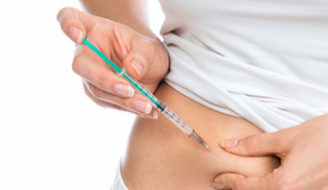
CPT 1 inhibition and diabetes
Etomoxir inhibits ketogenesis, gluconeogenesis, and increases glucose oxidation in fasted and diabetic animals (ref. 11; 41) and humans (ref. 19; 89) by lowering the rate of long-chain fatty acid oxidation. As a consequence, the NADH2 /NAD ratio is decreased and the end-product of the ß-oxidation – acetyl-CoA – is reduced. The reduction of acetyl-CoA limits the ketogenesis. Due to the fact that acetyl- CoA is an activator of the pyruvate carboxylase, a decrease in acetyl-CoA leads to a deactivation of pyruvate carboxylase and limits so the synthesis of oxaloacetate as a glucose precursor in the liver. A second mechanism for inhibition of gluconeogenesis is the decrease of pyruvate due to an increase in the flux through the pyruvate dehydrogenase (PDH) reaction. It has been shown that Etomoxir increases both, total PDH activity and the active form of PDH, respectively. The changes in NADH2/NAD and the decrease in acetyl-CoA/CoASH ratio also favour glycolysis and glucose oxidation as key enzymes of glycolysis (phospho-fructokinase, PDH) become de-inhibited.
A lot of evidences have been accumulated from animal and human studies that Etomoxir can increase glucose oxidation and insulin sensitivity and decrease both, blood lipids and muscle lipids, respectively. The cause for this might be increase in the LCFA-CoA/LCFA-carnitine ratio by blockade of the entry of LCFA-CoA into the mitochondria. This enhances the re-esterification but also leads to feedback inhibition of lipolysis and fatty acid de-novo synthesis as has been demonstrated in hepatocytes, isolated heart and rat in vivo experiments. (ref. 83; 187). In humans, healthy or diabetic, Etomoxir lowers blood triglycerides up to more than 50 %. There are evidences that Etomoxir reduces insulin resistance in insulin-resistant humans as type 2 diabetics (ref. 29; 55; 65; 89; 93; 113; 123; 147; 172). Etomoxir has no direct effect on insulin secretion but there are hints that Etomoxir has a positive effect on insulin binding on the insulin receptor in hepatocytes (ref. 90).
Therapeutic effects of Etomoxir could be shown in different diabetic animals as STZ-diabetic rats, genetically diabetic mice (db/db), and sand rats. Animals in these studies showed a significant decrease in fasting blood glucose concentration and urinary glucose excretion as well as an improved glucose tolerance test (ref. 40; 133). These effects were proportional to the dose and duration of treatment, and were parallel to increased food utilization and decreased water intake. In this long-term experiment with db/db mice, the life-span of treated animals were significantly prolonged in comparison with the untreated animals (ref.40).
The results of the human pharmacological and clinical phase II studies demonstrate that Etomoxir is safe and well tolerated up to
160 mg/die. The clinical phase II studies in type 2 diabetics show a moderate dose-dependent decrease in fasting blood glucose and a marked decrease in blood triglycerides, total and LDL-cholesterol, and ketone bodies, while HDL-cholesterol increases statistically significant (ref. 56; 65; 89).
